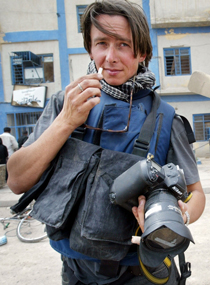 |
WAR WITHOUT END
May 2006 |
 |
|||||||||
|
To say that nothing can prepare one for the misery that awaits in the eastern Congolese city of Mongbwalu is a lie. For its plights and desolation have been exposed and offered up to the world on numerous occasions. The images of thousands of both the young and old scrapping away at the earth in a desperate search for flakes of gold have been shown, but like so much of what comes out of the Democratic Republic of Congo, these exposures, these depictions of a small hell on earth, are too often met with a collective shrug.
First some facts:
• An estimated 1,200 people die every day in Congo from war-related disease and hunger. That is close to 3.9 million since 1998.
• Since the end of 2005, nearly 1.7 million people have been displaced in Democratic Republic of Congo.
• There are an estimated 40,000 (conservative estimate) victims of rape and gender-based violence in Congo.
• There are over 33,000 child soldiers currently active in Democratic Republic of Congo.
• Democratic Republic of Congo is the size of Western Europe and has virtually no paved roads.
• There are 18 natural resources motivating the fighting in Congo, including gold, copper, gas, diamonds and ore.
While it is difficult to pinpoint a front line, bestow blame or articulate a solution to this conflict, what is happening in Congo is certainly war. In all honesty, I have heard more gunshots near my home in Brooklyn, New York, than I did in nearly a month in Congo. But war is often at its most pernicious when elusive and intangible. The horrors currently unfolding in Congo happen too often outside of the camera's sight; they slip like shadows across a wall that will be dismantled at dawn.
I had come to Mongbwalu to do a report on the gold mining activities in the town, one of numerous stories I pursued in Congo and felt was integral to the country’s state of crisis. Located in the violence-prone east of Congo and some 50 miles from the regional capital of Bunia, Mongbwalu should be reached by a short ride in a car. However, the Democratic Republic of Congo, a country roughly the size of Western Europe, has virtually no paved roads. That car trip ride becomes a 7- to 10-hour journey on a gnarled and rutted path replete with rebels, displaced families and hawkers of all varieties, in effect, isolating communities and towns throughout the country. The volatile east of the country, which is situated hundreds of miles from the capital, Kinshasa, has been the focal point of continued violence. Numerous militias and warlords have vied for control of the mineral rich eastern Congo for decades, creating instability and continued bloodshed.
The road into Mongbwalu is best navigated, like so much of Congo, on a motorcycle. Not only does this let one maneuver the streets, but it offers a fervent introduction to the smells, sounds and life of this vivid country. Mining is the trade of this town and has been for decades. The rusting shacks along the street that serve as shops display a colorful mix of mining buckets, rubber boots and shovels. After negotiating a "fee" with a dizzying number of local elders in order to operate as a journalist in the area, I head up the road to one of numerous mines on the outskirts of town.
Instead of casualties mounting in a barrage of shells, the swelling number of deaths in the Democratic Republic of Congo is often less dramatic. Maybe that helps explain why in the near month I was there, traveling to numerous cities and towns, I only encountered one other group of reporters, a Sky Television crew there for a week. Maybe it is that when death comes by malnutrition in a sordid hospital ward at 2:16 a.m. in a small and inaccessible village, it escapes notice. When relatives and community members march the simple wooden casket down the dirt road the following morning and place the body in an unmarked grave, it escapes notice. When a child shivers in the tropical heat and slowly dies from treatable tetanus, it escapes notice. But when these tragedies are repeated 1,099 times a day, it really shouldn't escape notice.
© Spencer Platt
Dispatches are brought to you by Canon. Send Canon a message of thanks. |
||||||||||
Back to May 2006 Contents
|
|



